Even if you don’t know this plant by name, you’ve almost definitely seen plantain growing in the wild before! Typically dismissed as a weed, plantain has a long history of use as a healing plant, often called “nature’s band-aid.” From varieties of plantain to its edible and medicinal uses, here’s everything you need to know about foraging for this mighty yet often underestimated plant.
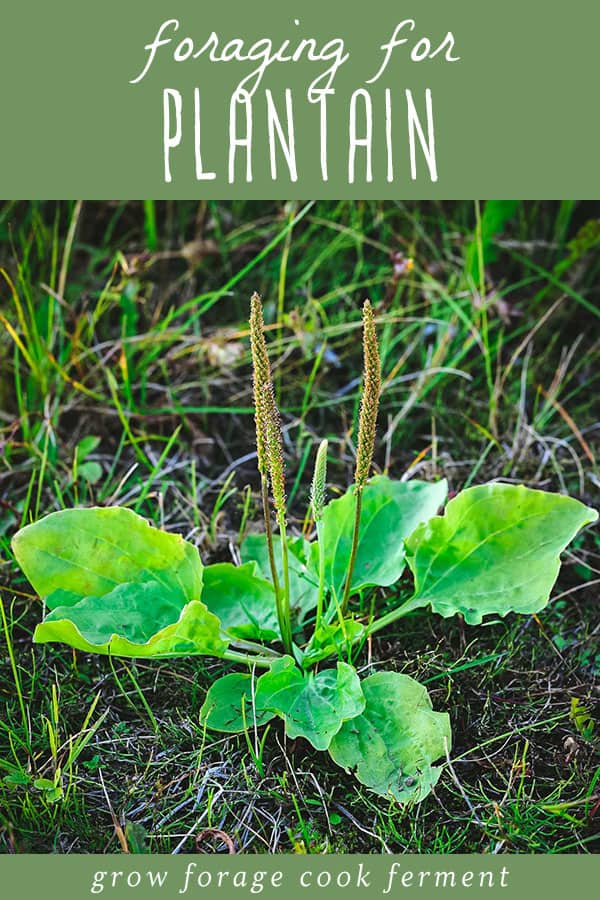
Want to save this post for later?
Wildcrafting Weeds
If you want to learn more about the edible and medicinal weeds that surround us and how to use them, check out my eBook: Wildcrafting Weeds: 20 Easy to Forage Edible and Medicinal Plants (that might be growing in your backyard)!
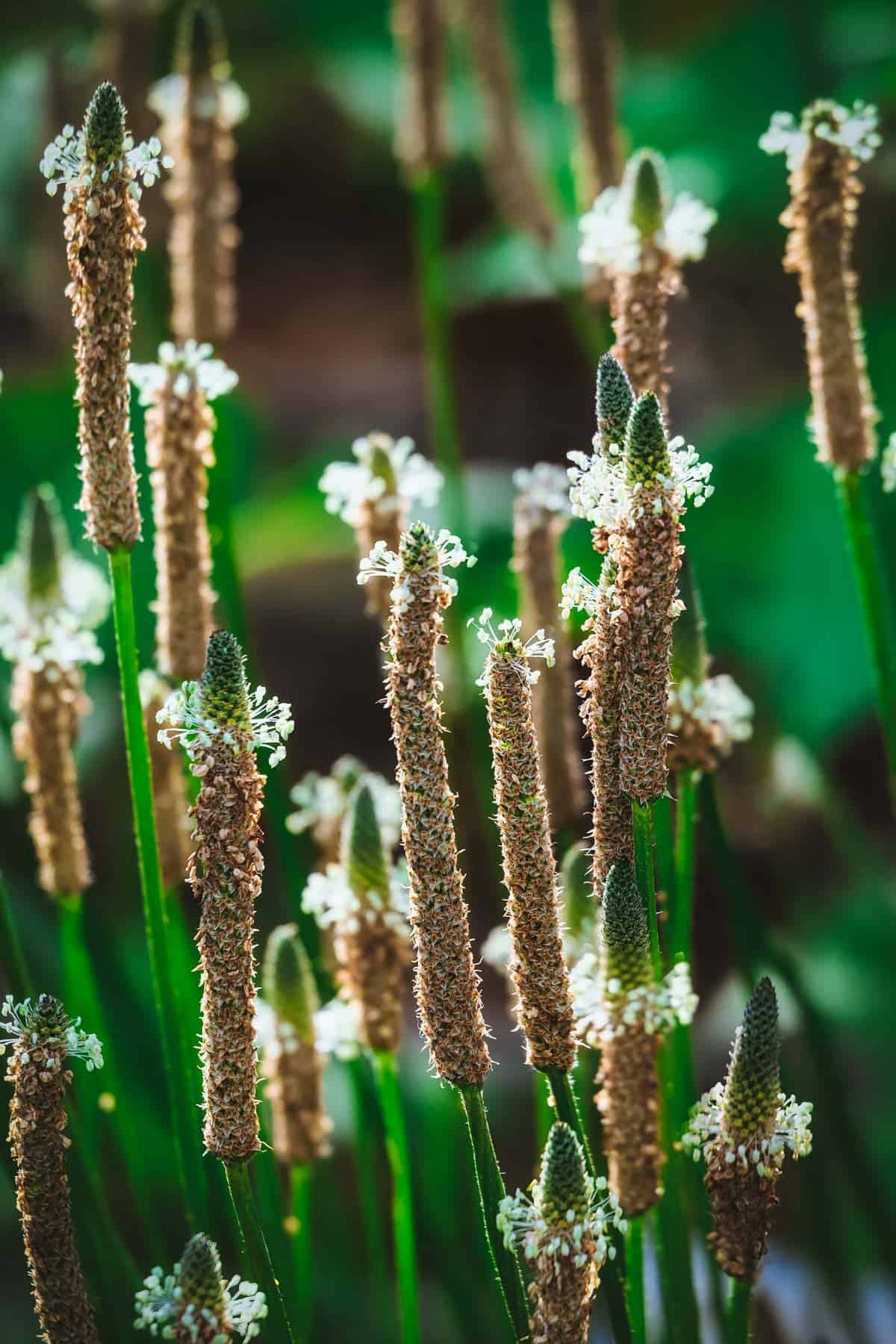
All About Plantain (Plantago)
Plantain (Plantago spp.) is native to Europe as well as northern and central Asia, but it can be found growing in the wild all over the world, probably even in your backyard. There are several different species of Plantago that grow worldwide.
You can find three main species of plantain in North America: Plantago major, Plantago Rugelii, and Plantago lanceolata (which grows in abundance in the Pacific Northwest).
Plantain is a truly hardy plant, it grows year-round in many different climates, although it will die back when exposed to harsh winters.
You can eat the leaves and the seeds of plantains, or you can use plantain for its numerous medicinal properties.
Related: 13 Early Spring Edible Wild Greens, What to Forage in Spring: 20 Edible and Medicinal Plants and Fungi
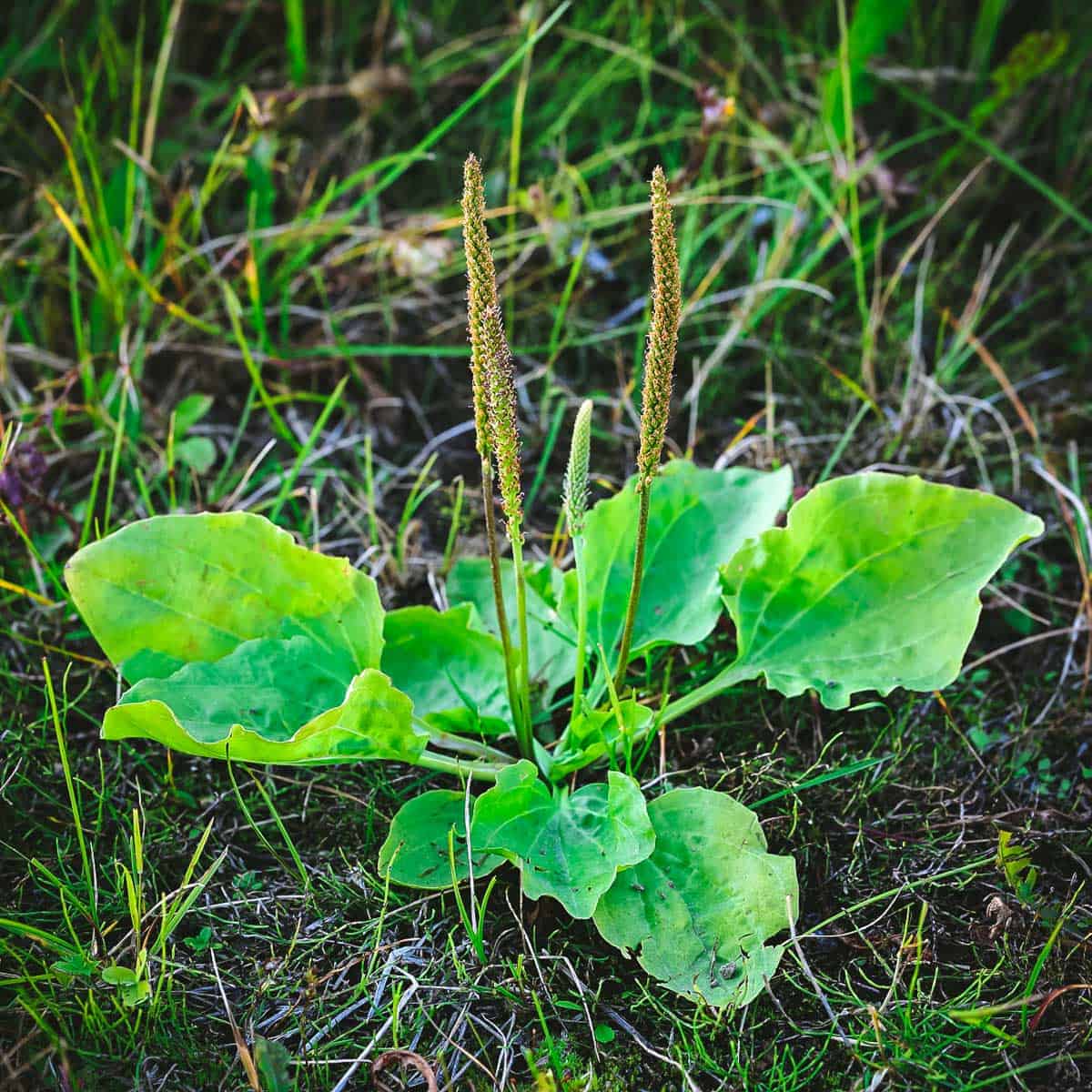
Where and When to Find Plantain
Plantain isn’t picky about where it likes to grow, and it’s found in a variety of habitats all over the world.
In fact, plantain is so common that once you identify it, you’ll wonder how you ever missed it in the first place!
Look for Plantago in yards, alongside roadsides, and in disturbed areas. Plantain grows in the shade or in the sun, so check both areas thoroughly when foraging.

Identifying Plantain
Wild plantain grows low to the ground and has distinctive leaves with prominent parallel veins. These leaves grow in a basal rosette, which means they grow at the base of the plant, the leaves overlapping to loosely form a rose-like shape.
Plantain is also identifiable by its prominent central flower spike. This spike is covered in very small flowers, each of which has four transparent petals.
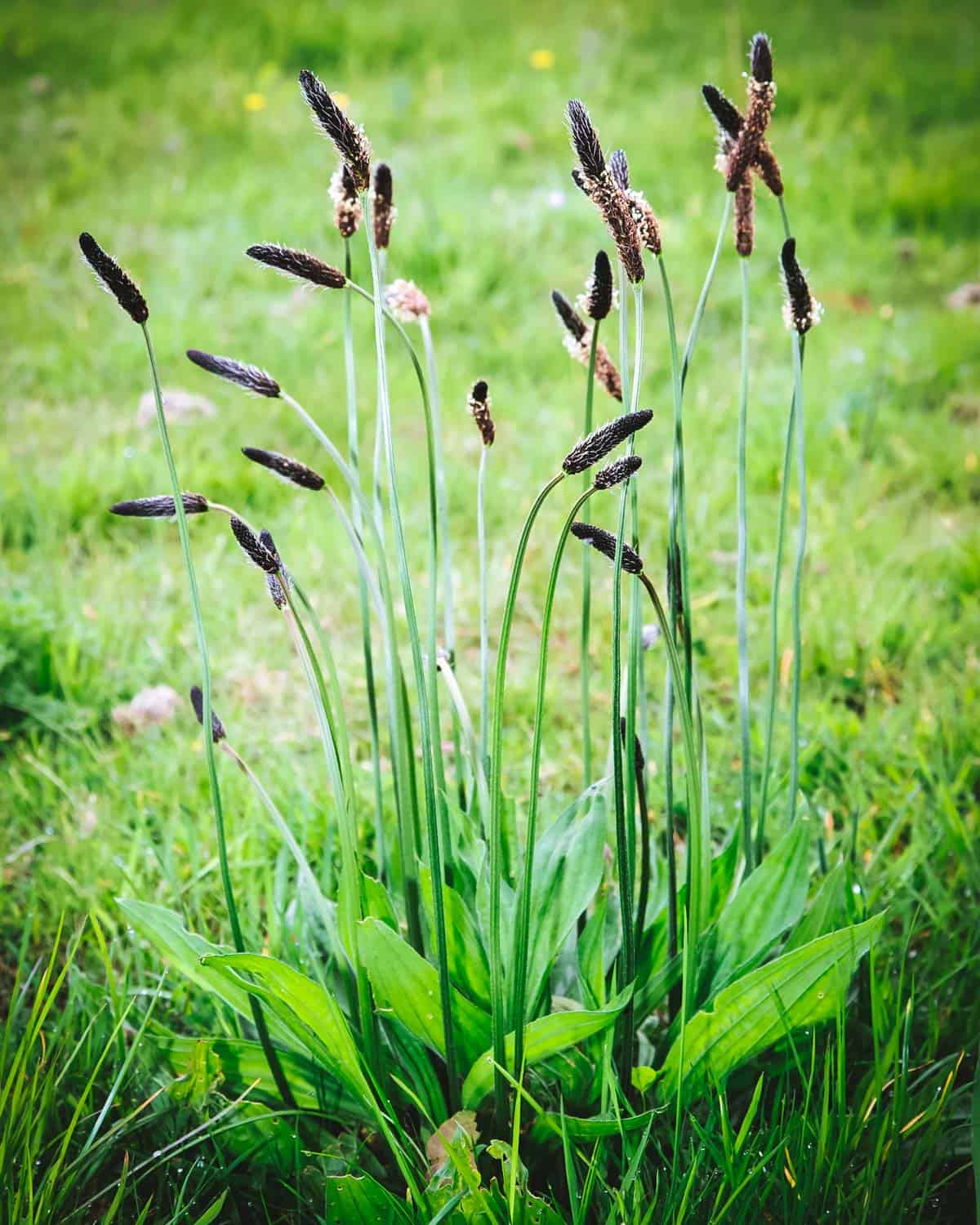
The differences between the three species of Plantago commonly found in North America are easy-to-spot, even for beginner foragers:
- Plantago major, also called broadleaf plantain, has broad, oval-shaped leaves.
- Plantago lanceolata, also called narrowleaf or ribwort plantain, has narrow, lance-like leaves that come to a point.
- Plantago rugelli, also called blackseed plantain, looks like a taller broadleaf plantain with purple where the leaf and stem meet.
I always recommend getting a foraging guidebook, especially if you are new to identifying plants. See my favorite books on foraging and wildcrafting to get started.
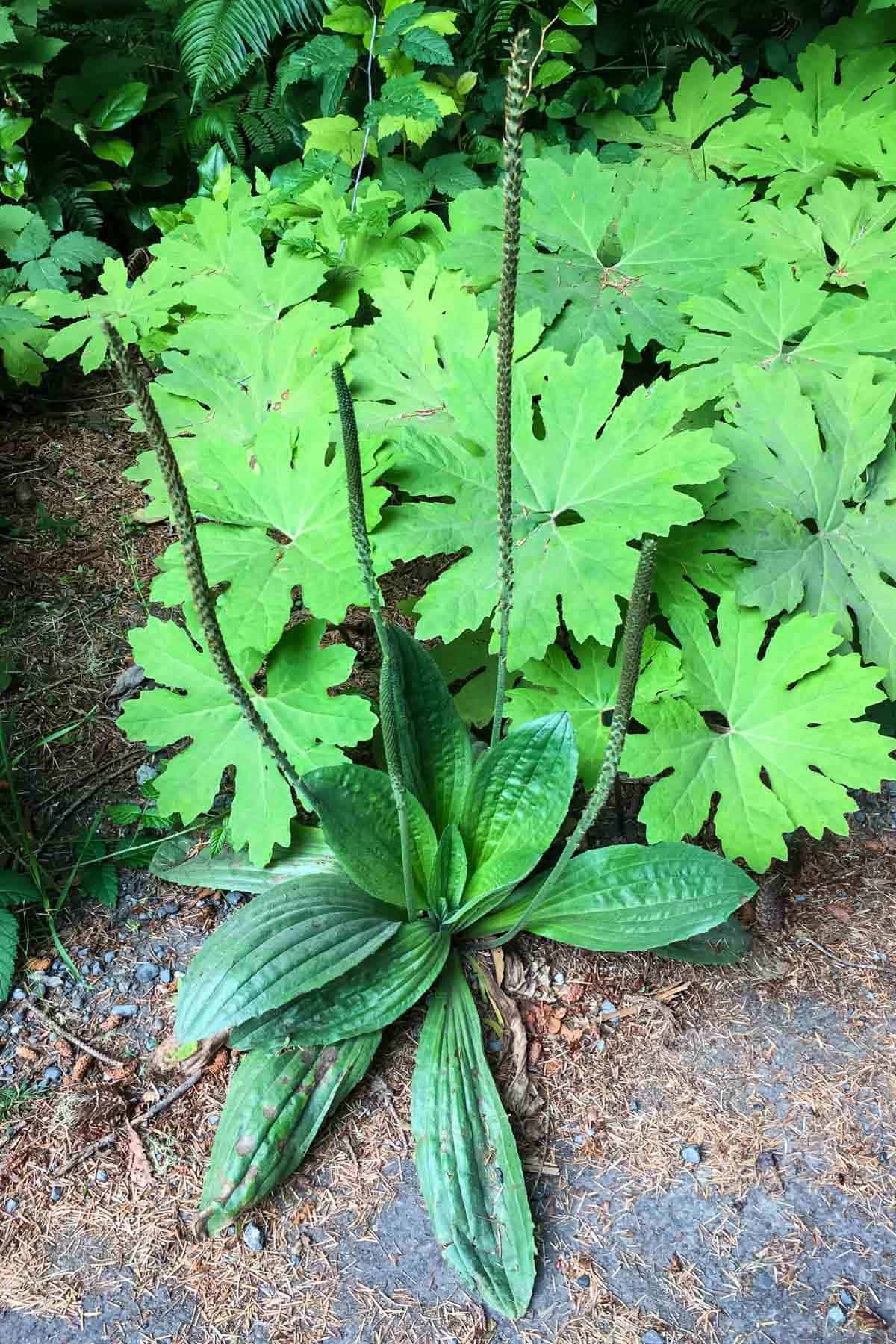
Harvesting Plantain
One of the reasons I love foraging for plantain is that it can be harvested any time during its growing season (which for some people, means all year round).
Young leaves are ideal for eating and while older leaves are still edible they become fibrous and difficult to chew.
Preserve plantain leaves by drying them — a dehydrator does a great job of getting the leaves as dry as possible for storage.
As with any foraging expedition, make sure you have permission to harvest plantain first, whether that’s from a neighbor or a park board.
Always, always make sure plantain — any other plant you’re foraging — hasn’t been sprayed with pesticides or any other poisonous chemicals.
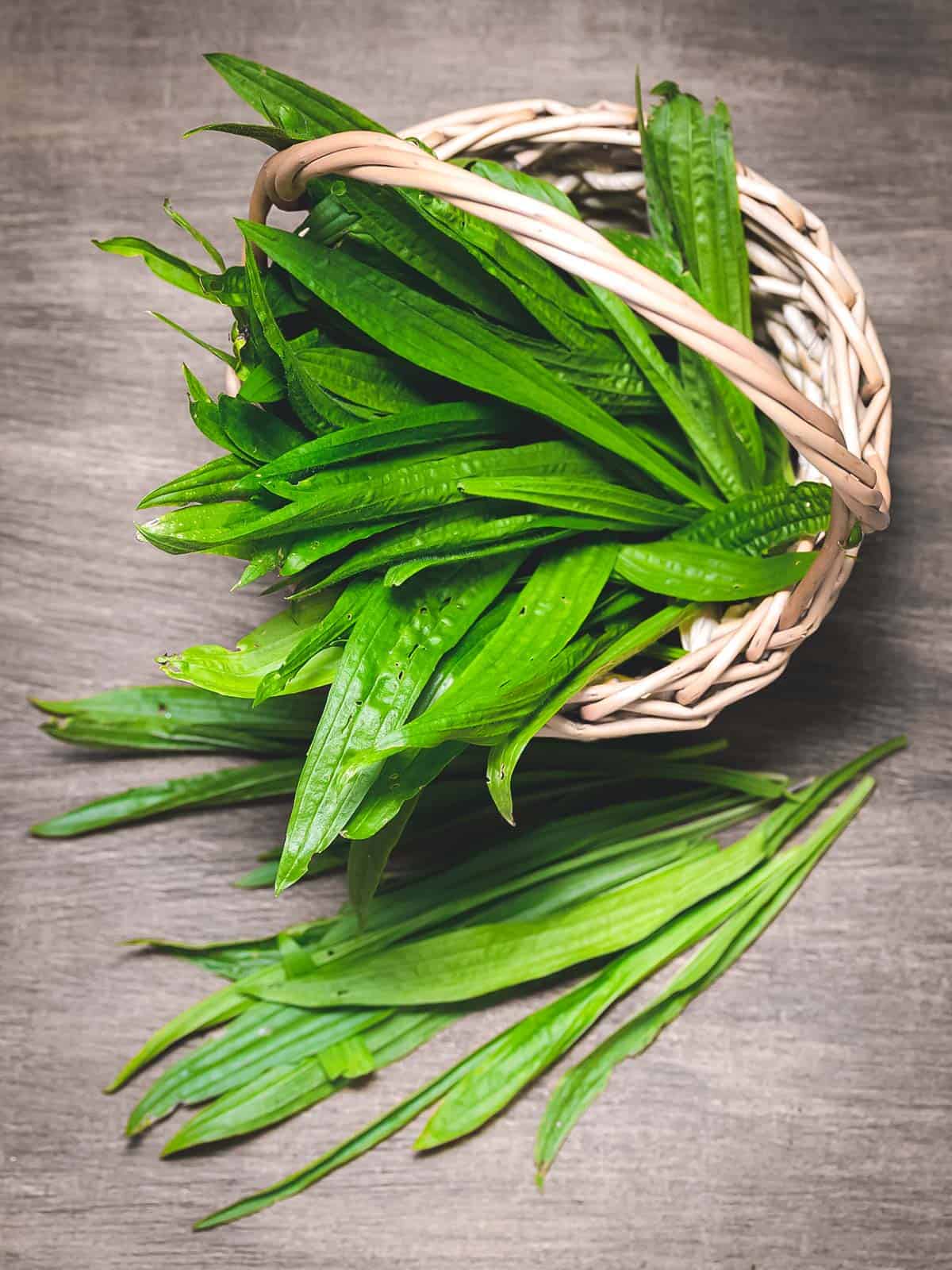
Plantain Look-alikes
Plantain has very few natural look-alikes, and the plants that do resemble Plantago are all non-toxic. Yet another reason why plantain is such a beginner-friendly plant!
Hostas, which are sometimes called plantain lilies, are similar in appearance and their leaves and shoots can also be eaten.
Edible Uses of Plantain
Like other types of wild greens, plantain leaves are super-nutritious and loaded with vitamins and minerals. Plantain leaves are high in vitamins A, C, and K, as well as being a source of iron, calcium, and magnesium.
Young plantain leaves have an earthy, slightly bitter flavor and they’re a welcome addition to soups and stews, just as you would with other dark leafy greens.
If you love snacking on kale chips, try these easy baked plantain leaf chips — this recipe would be perfect to make for a delicious snack on the trail.
Harvesting plantain seeds is labor intensive and only produces a small yield, but they can be ground into flour or left whole and sprinkled on top of salads.
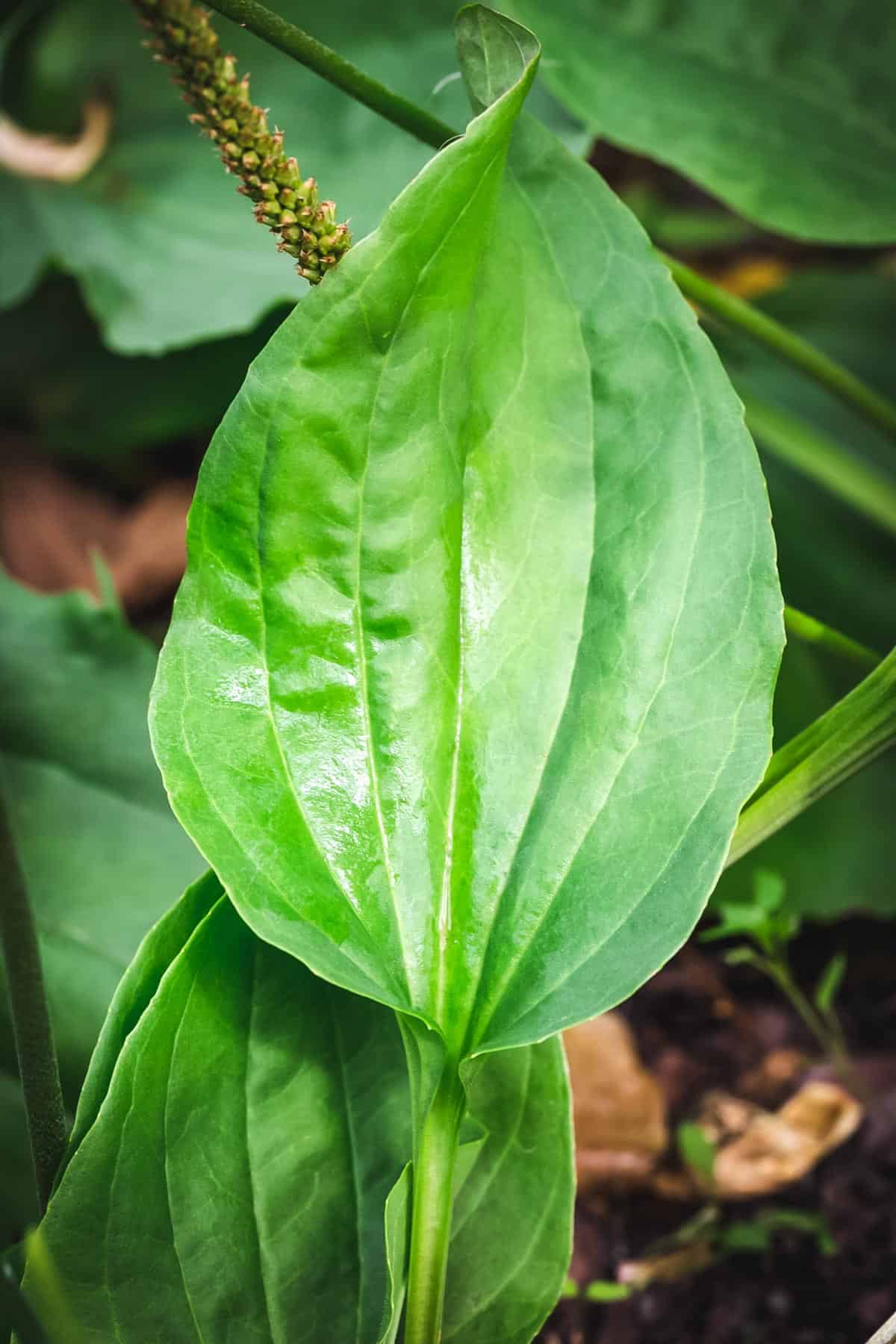
Medicinal Uses of Plantain
Plantain has a long list of healing properties. In my opinion it’s one of the best all-purpose plants to have on hand!
Because Plantago has antibacterial, antimicrobial, anti-inflammatory, and astringent properties, it can be used for a variety of common ailments.
Plantain leaves that have been partially chewed can be topically applied as a poultice for bug bites, scrapes, and rashes. It’s a good to know how to identify plantain leaves when you’re out camping, hiking, or out in the field for this reason!
Or you can go a step further and use plantain leaves to make your own natural bug bite remedy.
I use these cooling aloe plantain cubes if I’ve had too much sun. The combination of aloe and plantain blended together and then frozen provides instant relief on tender skin.
Plantain leaves are highly effective at helping to heal minor wounds, cuts, and scrapes. They are a perfect addition to homemade salves and balms such as this plantain salve or herbal healing salve.
You could also make this dreamy lavender plantain lotion (apply on dry skin just before bedtime for best results).
The outside coating of plantain seeds are called psyllium husks and, thanks to their high-fiber content, are used as a digestive aid.
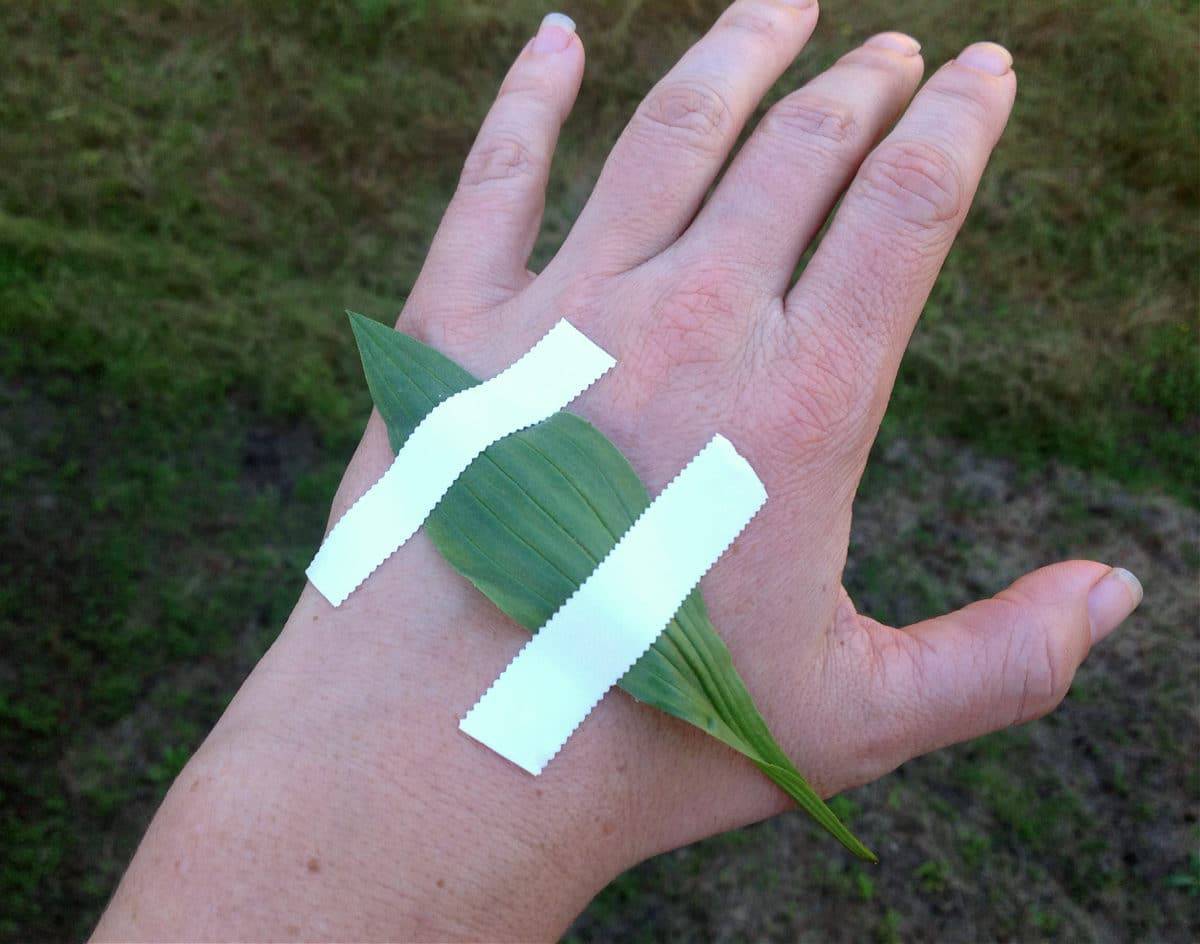
Where to buy plantain leaf
If you can’t find any plantain, or if it’s the wrong season, you can always buy dried plantain leaf from Mountain Rose Herbs (my favorite place to buy high quality, organic herbs).
For now, though, especially in spring and summer, keep your eyes open for this wonder plant! If you’re like me you’ve been looking at it ever since you were a kid, but haven’t realized the hidden medicinal properties that are within it.
This is the kind of knowledge that is getting lost through the generations. Let’s not lose it for good! I guarantee it will be important for us to know how to use plants like plantain in the future.

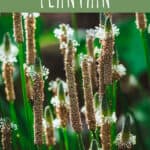
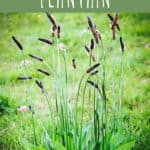
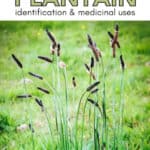
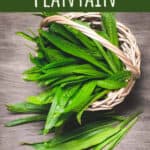
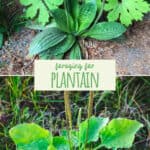
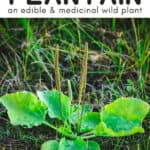
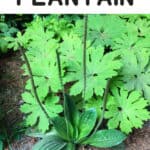
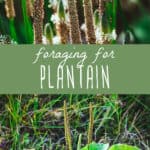

Also grows near stinging nettle use to stop the sting
Thank you for all this wonderful herbal info.
It is said that a video is made about herbs with unrelenting advertisments. Herbalists are non-conforming. Begone with the ads.
I’m sorry, but I can’t do that. The ads are what allow me to offer my audience free content while still making enough money to run my website and support my family.
And you do a great job Colleen. Thank you.
Hello Coleen, I live in Lago Puelo, provincia de Chubut en la Patagonia Argentina. We also have plantain in our Woods. Last summer I was picked by a vasp in my neck. Only plantago leaves helped . Sorry about my english.
I’ve made a great Plantain healing salve for years & had a lady in town waiting for my next jar, for a while. She swore by it.
Just last summer I used some of the seeds I’d gathered (for its metamucile-like properties) to make flour. I’m sure this flour helped my wholewheat bread dough rise and form the all-important air bubbles.
Thanks very much for the chip recipe. I’ll try this with my grandsons this summer. They’re usually up for trying one of their Weedy Grandma’s food experiments. : )
Hi Peggy! Thanks for sharing your tip about using the seeds to make flour. I haven’t tried it, but I think I may give it a shot.
As a youngster growing up in the Arizona desert, I was always experimenting with forage for our livestock. I made the mistake of raking up some dried plantago ovata and bringing it home to my horses.
They never would eat alfalfa after that.
I soon noticed that after each load there was an inch or so of pink to purple seeds in the bed of the pickup.
I cleaned and boiled a bit and ate it like cereal with milk and honey. It was yummy. We soon started using it in that fashion on a regular basis for cereal and flour. I had no idea the husks were a laxative; we winnowed those and threw them away.
My horses soon grew so fat we had to cut back on feed.
That is So Cool!
Wow. Never would have guessed these things had a name, let alone all the medicinal uses! When I was growing up in the DC suburbs we used to bend the tough stem to form a “V” under the seed spike and yank upwards to shoot the spike off into the distance. Haven’t thought of that in years!
Oh my gods that brought back memories for me here in the uk!
OMG we did the same thing as kids in the fields in Germany! Yeah. Sweet memories :-)
This is AmAzing information! I have just recently started studying the different herbs and the benefits of weeds and flower. Its incredible! We have just about everything in nature that can help to heal and nourish us. I live in Canada, and we have plantain everywhere. I just asked my neighbour last week, if I could go forage in his backyard. They have tons of plantain and dandelion back there. Looking forward to creating foods, tinctures, balms and salves.
Awesome! Enjoy all your new wild edibles!
Hi, love your information about this common but useful weed! Is the Red-seed plantain fall into this category? This seems to be the one that is most abundant here in Kansas.
Thanks!
Stephanie B
When I’m exposed to poison ivy I break a few plantain leaves in half and put the cut edges together to rub the juice on the exposed skin. End of ivy. I’ve used it for years.
Great information. I’d love to learn more about Comfrey too. In the historical books I enjoy they call it bone knit.
Can the leaves be dried to be used later?
Thanks
I found a”home” in this blog, thanks for putting me onto a plant (plantain) that I have always looked at as a noxious weed.
Dandelions were in the same category until I began using every part of it as a food. The dried and ground roots make an excellent caffeine free beverage.
I have five varieties of mushrooms that are edible, one of my favorites is the belotus edulus found near and under evergreens.
I am reaching my ninety third year by eating well and working hard; maintaining a “positive” attitude was no small part of it!
Hello Hank, I read your comments as much as I can and wondering how you are. Have you tried the plantain chips yet?
I have a great deal of difficulty identifying plantain. We have lots of mullein, but I have yet to see what I can positively id as plantain.
Marshall Reagan I would love seeds!
When I was younger we pan fried individual leaves in butter, salted them and ate them like potato chips. Yum!
I live in the high desert southwest near Albuquerque. Do these plants grow around here? I’ve never seen any. Maybe the mountains near here will have them. The deal is, I’m handicapped and have to rely on others to drive me around. I have an all terrain scooter,so I can go through the woods without any problems. I just need to get there.
Hi there,
I live in Durango and we have them here. It’s really pretty much everywhere, and as the author stated, it’s often overlooked as a weed.
Have a happy day!
I live in central Texas. We have small patches of stinging nettle in one pasture. Growing throughout the nettle is plantain. I have crushed plantain in my hands and rubbed on skin affected by the nettle. Works wonderfully!
So glad to read about other uses!
Hi, I am from Mongolia, a land of wild nature and nomadic people. I have grown up drinking plantain decoction when feeling stomachache. Elders always told that it is a very good herbal treatment for a stomach problem. I love natural medicine
Drinking it as a tea?
The seed is used as psyllium in Metamucil type laxatives
OMIGOD I USED TO BRAID THESE WHEN I WAS YOUNGER CAUSE THE STEMS ARE TALLER AND THICKER THAN GRASS!!!
I did too !
Is this in Tennessee?
No, southern Oregon.
Yes. Plenty of it, too
Can p. Lanceolata and p. Major be used interchangeably for medicinal purposes?
Yes they can!
my back yard is full of the broadleaf plantain, I would love to give some of it away. I would love to give you all of the seed you need to get it started in your yard.
Where do you live, there is nine in my backyard!
I had no idea that plantain could be used as a natural band-aid. I like your point about how a poultice can be made by chewing the leaves and then applying it to the wound. I’ll be sure to keep this in mind if I ever find myself in the woods and in need of medical aid.
Are they called buckhorns? That’s what we call them here in Michigan…at least that’s what they look like in your picture
I’ve only heard of them called White Man’s Footprint, but I live in the UP.
Buckhorn is what we call them in Indiana too
Saliva and mouth bacteria are safe to put on open wounds? Is there another recommendation for making a poultice?
Cj: My sentiments exactly. I would like to know if extraction with ethanol or some other solvent may work in preparing a “poultice”. In the meantime, I’ll chew it and spit it on my dogs when they get hurt.
I’m curious regarding tea preparation as well. I love that this plant is so common, and it seems we have many species in N Central FL.
I use my herb grounder. I forget what they’re called but it’s got the little club-like “pedestal” (?) and the bowl and you grind herbs in it.
It works well for plantain as well
Mash it up really well. In the field you could find a flatish rock and to place it on and a round or square rock to squash it with.
When you burn your finger cooking ,where does it go first, before you run cool water over it? In your mouth ,many times. Paper cuts are another that end up in your mouth ,first ,a lot of times . I’ve been a nurse almost 40 years working in areas such as Er,Icu,Burn Icu,Cardiac Icu. Never seen anyone come in with a plantain and saliva infection . Mostly saw or lopper injury to fingers ,or diabetic or dialysis patient problems that were more to do with circulation and immunity issues.
This is always my favorite plant to use to introduce children to nature and herbalism (well this and mulberries). Plantain is easy for kids to identify, easy to find, and they LOVE chewing up the leaves and putting the gross green goo on EVERYTHING! Especially when you let them know that it works on mosquito bites (which it does!). I’ve seen kids walking around covered in green polkadots, just because they think it’s so fun. Every tiny, two week old, healed-over abrasion seems to require a big wad of partially masticated plantain. It’s hilarious, and they come away feeling like nature is the coolest thing ever!
Hi Meredith,
What about mulberries? i only know of eating the berry…what else can you do with mulberry?
The leaves! Mulberry tea is a fantastic non-caffeine tea and the leaves can even be ground to create a non-caffeine, matcha-type powdered tea. It is said to lower blood pressure, and have benefits for diabetics because it can bring down blood glucose levels. It also tastes quite nice. This tea is common in Korea, and known in Japan and other Asian regions. Traditionally, it is drunk pre-meal or during meal, because it is supposed to have sugar-blockers (DNJ).
We live on the south Oregon coast and I am glad to have found your blog. I just started my blog and it seems we are on the same wavelength. I hope we can collaborate in the future, especially as I get more entries on my blog. As for the Plantain, it does a wonderful job when it comes to small cuts or bee stings but a new use I have discovered is a tincture of 3/4 Sage and 1/4 Plantain. It is used to relieve the issues of poison oak and poison ivy. I have yet to try it personally but have a tincture brewing in my cabinet right now and will be using in this next year. BTW Chanterelles are popping up everywhere right now, we already have all the Lobsters we can use.
Bruce & G’ganna
How do you prepare your tincture Bruce?
Just wanted to add a note….. There are other varieties of plantain plants too. In Iowa, where I live, ours have short round leaves and the seed head is long and narrow (not pointed like in your pictures). Just in case someone went looking for what is specifically pictured above. Thank you for the information though. :)
I have seen both types in Maryland
There’s actually a bunch! Do a quick Google image search for “plantago” and you can see them. They favor different environments but can all, due to their weedy habits, survive in various locales, and they are all medicinal magic. I imagine the Iowa plantago prefers more consistent water than its California sibling that doesn’t blink at long dry spells.
Both types are here in Washington/Oregon as well…my question is do they share the same properties? I have used both in salves, but still curious as I didn’t see the one Chele mentioned in Colleen’s book. Thank you.
Yes, all plantain species have similar benefits.
Bryan, Katrina Blair has a whole chapter on plantain in her book, “The Wild Wisdom of Weeds: 13 Essential Plants for Human Survival”. I know she talks about making powders. http://www.chelseagreen.com/bookstore/item/the_wild_wisdom_of_weeds:paperback
Great post Colleen! I wonder, would plantain also work well dried, for teas and such? I feel like it would come in handy in the middle of winter when coughs and colds are more prevalent.
Amazing!